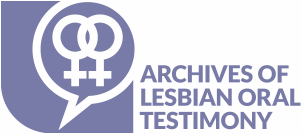What is an Oral History?
What is an Oral History?
Every day we tell stories. When we’re recounting our Friday night adventures to a co-worker, or promising ourselves we’ll get to the housecleaning tomorrow, we’re telling stories. We use stories to make sense of the world around us, and to build relationships with each other. Oral history and oral testimony is one kind of story-telling. The most common type of oral history you’ll find in the Archives of Lesbian Oral Testimony originated in the 1960s, a time when, in the global north, revolution was in the air. No longer content to inch their way toward social justice, young radicals sought to turn the world on its head. They rejected everything top-down, including histories that emphasized military, business, and government leaders as great nation builders. Instead, they wanted to talk about how labourers, immigrants, women, and racial minorities (to use the language of the time) were the real backbone of the nation. But how would they do that? Traditional archives where historians sift through records of the past seemed almost silent on those topics, and when everyday people were represented, it was usually from the perspective of elites. Researchers got creative. They went out into the community and interviewed elders about their day-to-day experience, and thus created a new type of historical record (and for historians, a new research methodology — anthropologists had long used such interviews in their research). They asked questions about growing up, going to school, getting a job, having children — the usual milestones in life. They looked at interviewees’ personal photo albums, read their stash of old letters and newspaper clippings, and drank tea. Lots of tea.
LGBTQ history
The gay and women’s liberation movement underwent a similar process of radicalization, and use the same creative methods to write themselves into history. Groundbreaking American studies like Coming Out Under Fire: The History of Gay Men and Women in World War Two and Boots of Leather, Slippers of Gold: The History of a Lesbian Community hit the bookshelves and readers were exposed to a whole new way of thinking about the past.


Oral history as a research method
Oral history was not immediately accepted as a “legitimate” research method. Its critics argued that memory was too subjective, the information one could glean from an interview was biased and partial. Oral history could never be objective. It is now widely accepted that there is no such thing as true or pure objectivity. Even the most traditional archival sources such as military records or a political speech are biased and subjective. Historians guard against errors by checking one source against others, and oral historians are no different. Oral interviews have also allowed us to explore new ways of knowing the past, as well as the present. It has opened up new questions about memory and even trauma, and to consider more carefully the value of storytelling as a form of knowledge. But perhaps the most exciting thing is it makes “doing history” something anyone can take up. From grade school children interviewing their grandparents, to a LGBTQ community centre launching its own local oral history project, it requires only a curious mind and good listening skills and is a wonderful way to get to know people and the world around us. The housecleaning can wait.

